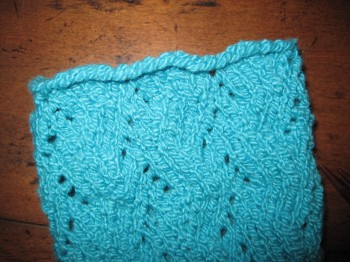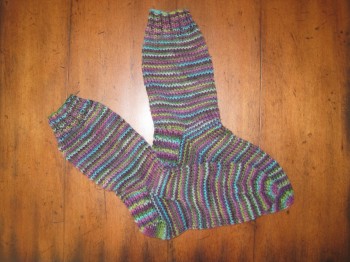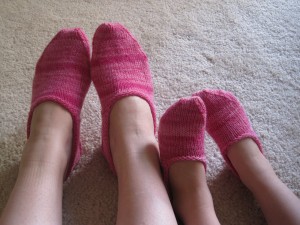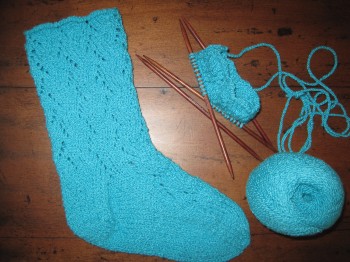A little over a week ago, my daughter was getting ready for bed and put on some summer pajamas along with the mid-calf wool socks I knitted for her. Given that it was about 75 degrees in our house at the time, I thought she’d be way too warm in those socks. I asked her if she’d like me to make her another pair of bed socks (the short, footie-like socks, which she has long outgrown) and she said she’d rather have socks that come up a little higher. So I started thinking about what I might make for her that are more traditional socks but also better suited for warmer weather.
I went to my stash and looked at what sock yarn I had on hand. Seeing the Cascade Fixation yarn reminded me of the pair of socks that I knitted for myself in a somewhat open, lacy pattern using that yarn, which is mostly cotton with just a bit of elastic. The Fixation yarn with the lacy-ish pattern would make great warmer-weather socks for my daughter, and back when I originally ordered that yarn, along with the green for myself I ordered some teal, which is now one of my daughter’s favorite colors. Hurrah!
So last weekend I started on the new socks for my daughter, and this weekend I finished her first sock (and started on the other). Even after all these years of knitting, I still find it amazing that in one week I can go from having a ball of yarn, which is pretty and full of potential, but not very useful in its ball form, to having a sock, which will lovingly cover my daughter’s foot and keep it warm. The sense of accomplishment from making something, especially something useful, is one of the many things I love about knitting.

A close-up of the lovely herringbone lace pattern, which also happens to naturally create that pretty, rippled edge at the sock’s top.
The pattern I’m using is called “Herringbone Lace Socks” and the lace repeat is simple and easy to remember, but not boring. And it produces a really lovely sock. The pattern is by Ann Budd from her Getting Started Knitting Socks book. This is a fantastic book for beginner sock knitters; it has step-by-step instructions for each and every part of a sock, with detailed written instructions and photographs for each step. Plus there are patterns for socks at various gauges–from 8 stitches per inch using fingering yarn, to 4 stitches per inch using bulky yarn–and for sizes ranging from a kid’s medium (shoe size 9 to 12) to an adult’s large (women’s shoe size 11 to 14; men’s shoe size 10 to 13). If you want to start knitting socks and buy only one book, I highly recommend Ann Budd’s Getting Started Knitting Socks.




Hello,
Lovely socks and blog. Can you tell me how many you cast on for a ladies sock in Fixation? any tips about knitting with it?
Thanks much,
Hi Michelle,
Thanks for your comment and I apologize for not responding sooner. In November of last year we welcomed another lovely little girl and I have been otherwise occupied ever since. But she’s 10 months old now, sleeping well, and things are returning to “normal” around here, so I’m getting back to blogging.
You’ve probably moved on to some other pattern or project by now, but just in case not, to knit a woman’s sock with Fixation, you’ll need to cast on 48 stitches (to fit US shoe size 5-7), 54 stitches (to fit US shoe size 8-10), or 60 stitches (to fit US shoe size 11-14).
Because of the elastic in the yarn, you have to be extra-careful with tension. Just make sure you give the yarn some slack; don’t pull it taut when knitting, and then you’ll ensure there’s some forgiveness (stretchiness) in the resulting sock. My other piece of advice would be to knit both socks either at the same time or in close succession so whatever natural rhythm you fall into with holding the yarn/tension will be consistent between socks.
Thanks again for your comment, and happy knitting! Samantha